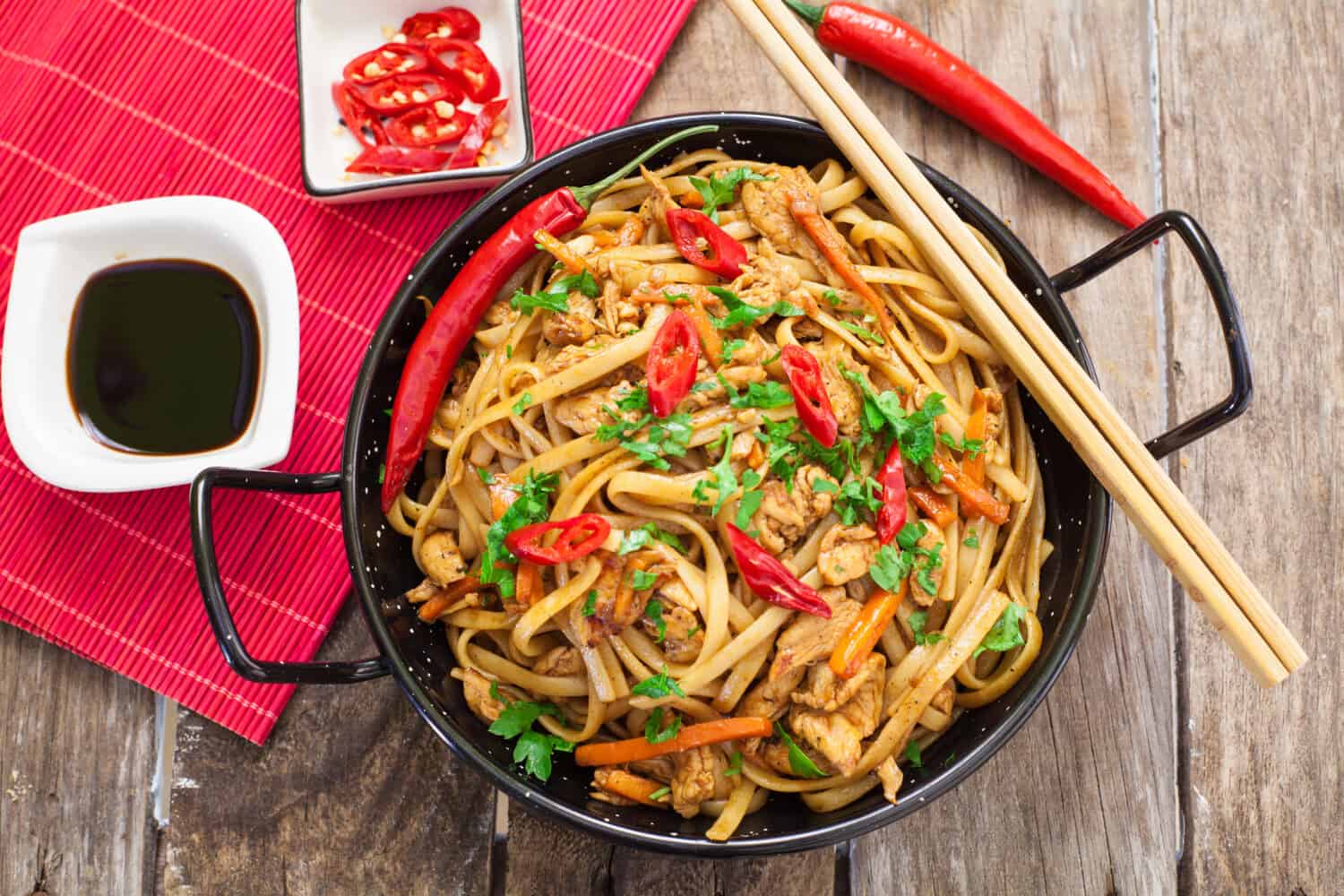In the mood for Chinese cuisine, but unsure what sounds best? You're in luck! Today, we're uncovering the differences between two well-known dishes: chicken chow mein and chicken lo mein.
While these two dishes may look and sound the same, the variation lies in how the noodles are prepared. For example, chow mein translates to fried noodles, while lo mein refers to tossed or stirred noodles. There's much to uncover about these dishes' distinct differences in textures, flavors, and cooking methods, so let's dive in!
Chicken Chow Mein vs. Chicken Lo Mein: What are the Differences?
In English, the word “mein” translates to noodles, making these dishes seem identical. As mentioned, however, the difference lies in how these dishes are prepared. Chicken chow mein noodles are first boiled and then stir-fried, giving them a crispy texture. Chicken lo mein noodles, on the other hand, are not stir-fried after they're boiled, leaving this dish with a soft and tender texture.
There are additional differences between these two meals, including the cooking method and the sauce and ingredients used for each. Let's take a closer look at each dish.
What is Chicken Chow Mein?
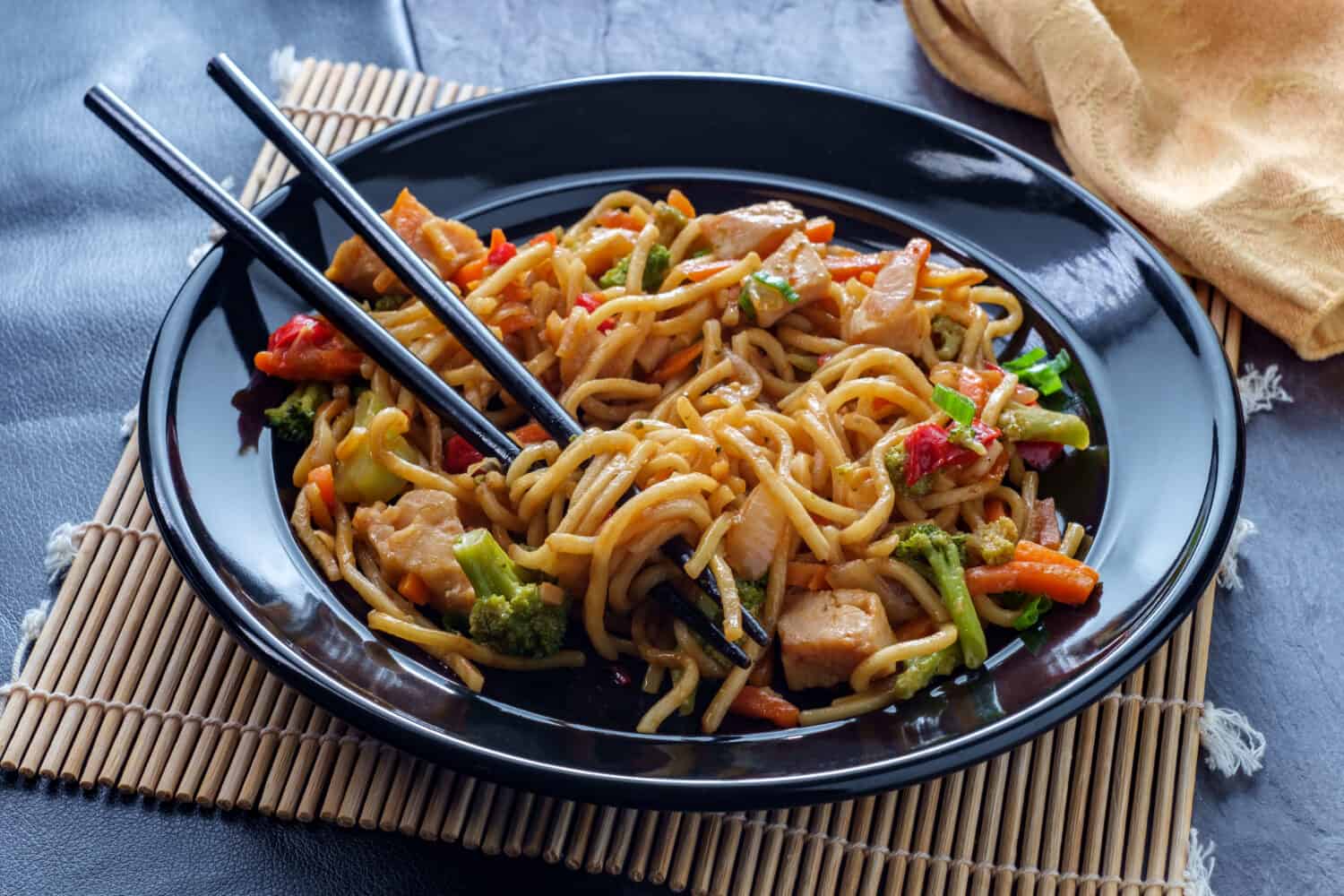
©Ezume Images/Shutterstock.com
As mentioned, chow mein is a Cantonese term that translates to “fried noodles.” This dish is known for its stir-fried ingredients and lighter sauce that doesn't overpower the crispiness of the noodles. Adding chicken and other various ingredients gives this meal a nice combination of both soft and crispy elements.
Origin
While the exact date of the first chow mein meal is unknown, this dish is thought to have originated in the Northern Chinese area. According to an article from TasteAtlas, chow mein was then brought to the U.S. by Chinese immigrants sometime in the 1850s.
The original dish was made to be light and included numerous ingredients as opposed to just protein and noodles. Chow mein has grown and changed over the years, however, and has been altered to include heavy amounts of protein and a thicker sauce. Other alterations of this meal include the chow mein sandwich, which originated from factory workers in Fall River, Massachusetts, dating back to the early 1900s according to an article from NPR.
While this meal has seen many variations over the years, chicken chow mein still remains a popular Chinese cuisine.
Texture and Flavor
Chicken chow mein is unique in that the noodles are soft on the inside, and crispy on the outside. The crispiness of the noodles provides a satisfying crunch, while the softness absorbs the flavors of the sauce and other ingredients. The overall dish tends to have a slightly drier texture, due to its stir-frying method and lighter sauce.
Cooking Method
The key characteristic of chow mein is the frying process. For chicken chow mein, be sure the protein is prepared ahead of time before combining all ingredients.
Traditionally, egg noodles are used to make chow mein. These are boiled until just barely done. Overcooking them can cause them to be soggy instead of crispy when fried. After the noodles are boiled, they are combined with the chicken (cooked earlier), various vegetables, and a lighter sauce before being stir-fried in a hot wok or skillet. This stir-frying technique gives chow mein its distinct crispy texture.
Sauce and Ingredients
Chicken chow mein includes two obvious ingredients: chicken and noodles. Various vegetables can also be added to this dish, adding a crunchy texture to the already crisp noodles. Great veggie options include cabbage, carrots, bean sprouts, and even mushrooms or bamboo shoots.
As mentioned, chow mein sauce tends to be lighter so as not to take away from the crispy texture of the noodles. The ingredients usually include soy sauce, oyster sauce, and light sesame oil. Chicken broth, cornstarch, and sugar are also added to give this dish a sweeter taste.
What is Chicken Lo Mein?
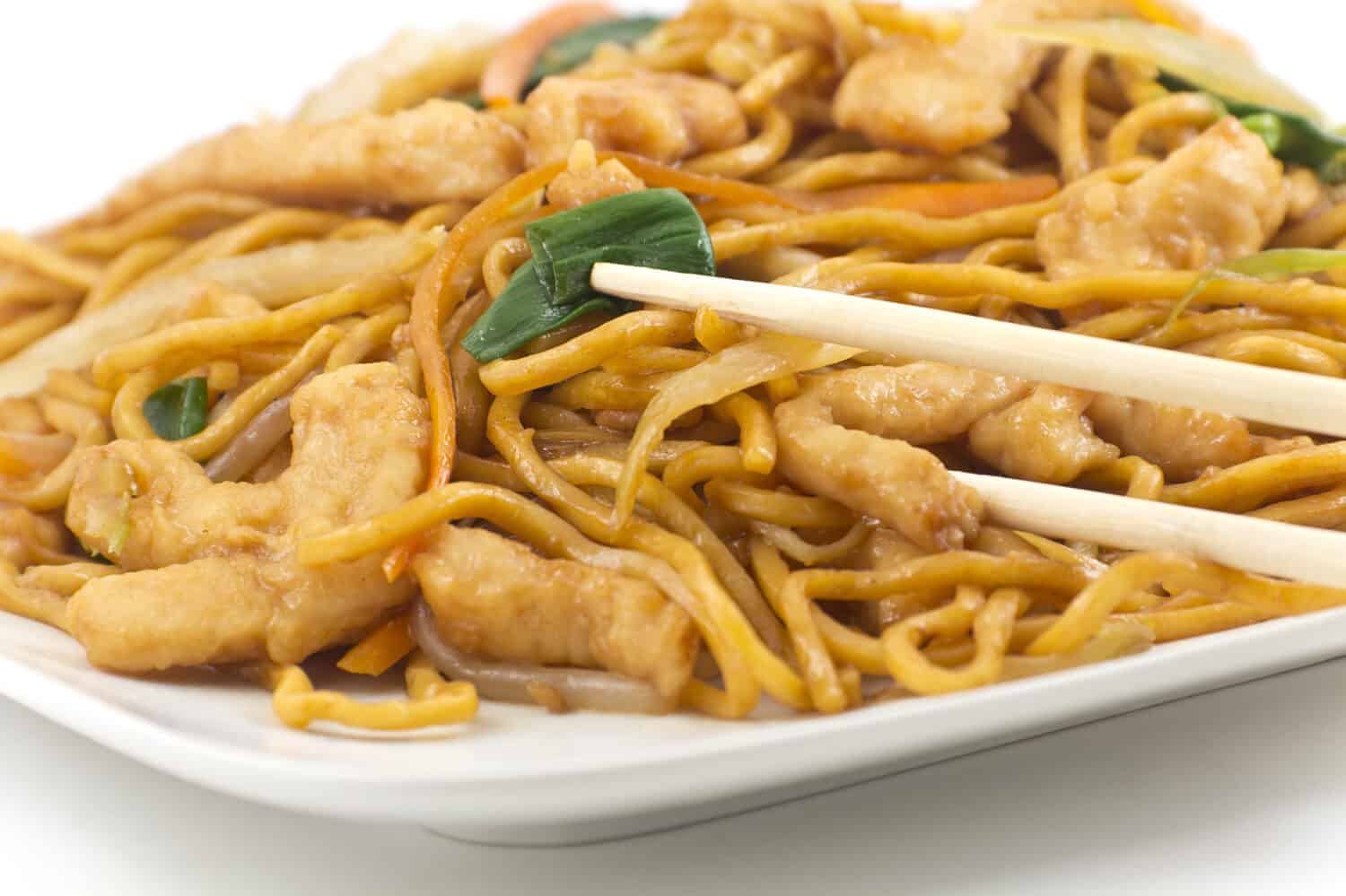
©Ezume Images/Shutterstock.com
As opposed to chicken chow mein, which includes fried and crispy noodles, chicken lo mein includes noodles that are fully boiled, giving this dish a softer more uniform texture. The sauce for this dish also tends to be thicker, fuller, and more flavorful. To combine the ingredients in this dish, the noodles are stirred or tossed into the sauce, referring to lo mein's meaning of “tossed noodles.”
Origin
Lo mein can be traced back to Guangdong, China according to TasteAtlas. In its traditional form, lo mein featured wheat flour noodles that were boiled and then tossed with a variety of ingredients such as vegetables, meat, seafood, and a flavorful sauce.
This meal has many variations as it's spread across different regions. For example, here in the U.S., lo mein noodles are often thicker and the dish typically includes a combination of stir-fried vegetables and protein.
Texture and Flavor
Chicken lo mein has a softer and more uniform texture compared to chow mein. The noodles are tender and often coated with a heavy, flavorful sauce, resulting in a more moist and saucy dish. The focus of this dish is the sauce, as opposed to the textural differences that chow mein offers.
Cooking Method
Unlike chow mein, lo mein noodles are not stir-fried after boiling. To begin, egg noodles are boiled and chicken is cooked ahead of time.
After the noodles are boiled, they are tossed together with the chicken, various vegetables, and a heavy sauce in a separate wok or skillet. The focus of this meal is on coating the noodles and ingredients evenly with the sauce while maintaining their soft and tender texture.
Sauce and Ingredients
Similar to chicken chow mein, chicken lo mein begins with the two most important ingredients: chicken and egg noodles. Various vegetables are often added to this meal as well. Carrots, bell peppers, chopped onions, and broccoli are delicious, sturdy vegetables that make a great addition to lo mein.
Lo mein sauce usually consists of both light and dark soy sauce, sesame oil, oyster sauce, ginger, and garlic. As mentioned, this sauce tends to be thicker and richer than chow mein sauce.
Print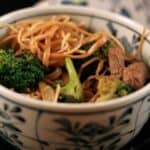
Beef Broccoli Lo Mein
- Yield: 6 servings
Ingredients
- 8 ounces uncooked spaghetti
- 1 teaspoon dark sesame oil
- 1 tablespoon peanut oil
- 1 tablespoon minced peeled fresh ginger
- 4 cloves garlic, minced
- 3 cups chopped broccoli
- 11/2 cups vertically sliced onion
- 1 (1 pound) flank steak, trimmed and cut across grain into long thin strips
- 3 tablespoons low-sodium soy sauce
- 2 tablespoons brown sugar
- 1 tablespoon oyster sauce
- 1 tablespoon chili paste with garlic
Instructions
- Cook pasta according to package directions, omitting salt and fat; drain. Combine pasta and sesame seed oil, tossing well to coat.
- While pasta cooks, heat peanut oil in a large nonstick skillet over medium-high heat.
- Add ginger and garlic, sauté 30 seconds. Add broccoli and onion; sauté 3 minutes. Add steak; sauté 5 minutes or until done.
- Add pasta mixture, soy sauce, and remaining ingredients; cook 1 minutes or until lo mein is thoroughly heated, stirring constantly.
Nutrition
- Serving Size: 1.3 cups
- Calories: 327
- Sodium: 382mg
- Fat: 9.3g
- Saturated Fat: 3g
- Carbohydrates: 39.1g
- Fiber: 2.9g
- Protein: 21.7g
- Cholesterol: 36mg
Chicken Chow Mein vs. Chicken Lo Mein: Nutritional Value
The total nutritional information on both of these meals can vary depending on how they are prepared, the ingredients used, and the portion size.
In general, both dishes contain a good source of protein with the use of chicken. Adding vegetables is another way to make these meals healthier as veggies add vitamins, minerals, and fiber.
Keep in mind, however, that the refined wheat flour noodles and oils used can add higher amounts of fat and sodium to the dish. To make both dishes more nutritious, consider incorporating a good balance of vegetables, opting for whole wheat noodles when possible, and controlling portion sizes. Additionally, you can explore lighter cooking techniques such as using less oil or opting for lower-sodium sauces or homemade sauce alternatives.
Are Chicken Chow Mein and Chicken Lo Mein the Same Thing?
As you can see, while these dishes seem identical, they vary in how they are prepared and what ingredients are used.
Chicken chow mein, with its fried noodles and lighter sauce, offers soft and crispy textures. Chicken lo mein, on the other hand, showcases tender, boiled noodles tossed in a flavorful sauce. This sauce creates a harmonious blend of flavors without the crispy element.
Final Thoughts
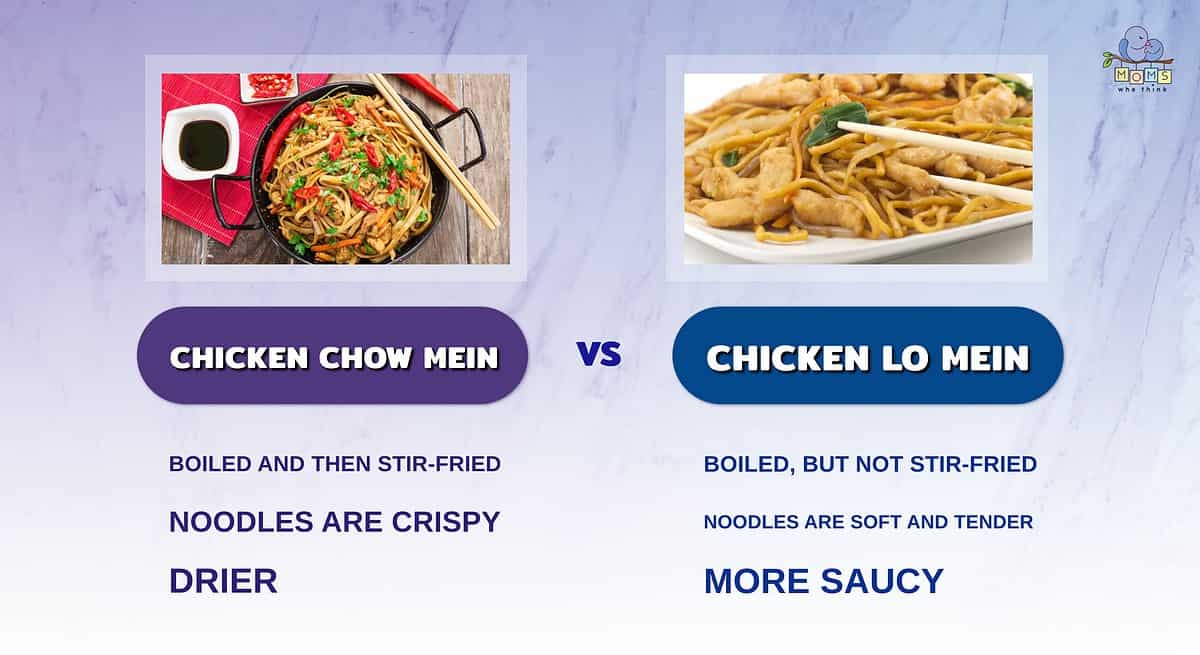
- The main difference between these two dishes is their preparation. The noodles in chicken chow mein are boiled, and then stir-fried. With chicken lo mein, the noodles are boiled but not stir-fried.
- The noodles in chicken chow mein are crispy, while the noodles in chicken lo mein are soft and tender.
- Due to the cooking method and lighter sauces used, chicken chow mein tends to be drier. Chicken lo mein is moist and more saucy.
In the end, whichever option you choose is sure to be a delicious choice. Whether you're looking for the crispy texture differences of chicken chow mein, or the soft and flavorful sauce of chicken lo mein, these dishes serve as a testament to the versatility and rich culinary heritage of Chinese cuisine.
The image featured at the top of this post is ©Ramon grosso dolarea/Shutterstock.com
